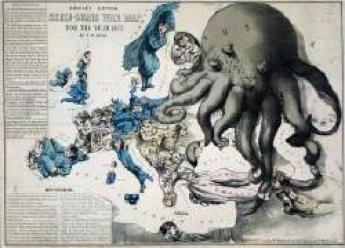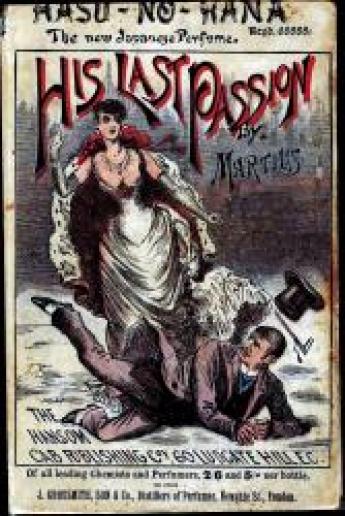Antiquarian Booksellers' Association
Collecting - The Serio-Comic Mapmaker Fred W. Rose

By Rod Barron
Fred W. Rose (1849-1915) stands out as the most influential figure in the design and authorship of the so-called “Serio-comic” political cartoon map in late Victorian Britain. His remarkable maps include: A Serio-Comic War Map, 1877 (published in three slightly different versions); England on Guard, 1878; A Comic Map of the British Isles, 1880; Angling in Troubled Waters, 1899, and John Bull and his Friends, 1900. All were published in London by G W Bacon & Co.
Rose himself became widely known and acclaimed as the “Author of the “Octopus” map of Europe”. What is especially curious is that despite this widespread recognition and the enduring popularity of his maps, until now, virtually nothing has been known about Fred W Rose himself.
Early in 2010 I was invited by Peter Barber to present an illustrated lecture on Fred W. Rose and his Serio-comic maps (which I entitled The Colossus of Rose) to a specially convened Academic Symposium at the British Library. The Symposium took place in June of that year and was scheduled to coincide with the BL’s superb Magnificent Maps Exhibition, in which several of Fred’s maps were on display.
In researching the background content for that 2010 lecture, it was inevitable that I would become increasingly captivated by Rose and his work and it was not long before I resolved to discover exactly who the “real” Fred W Rose was. Quietly & conscientiously, I began my own researches. What I had not realized was that others were also ploughing this same furrow as well, though perhaps with not such immediate success.
It was therefore a timely coincidence and a wonderfully appropriate way to mark the approaching Centenary of Fred W. Rose’s death (3rd January 1915) that just a few weeks ago, our own ABA Bookhunter on Safari, Laurence Worms, should have finally and definitively exposed the “real” Fred Rose and clarified many of the principal details of his life and career, based on his recent researches, and as featured in his excellent recent blog posting.1
Laurence’s revelations are to be warmly welcomed. A remarkable life and career, until now almost entirely lost to posterity, is finally been drawn out of the shadows.
My part in that long overdue process is now focused upon pulling together my own extensive researches, in order to publish, what I feel, is a much-needed book. Either a detailed biography of Fred himself or perhaps, given his remarkable range of interests & connections, a broader study that might shine a spotlight on features and aspects of that fascinating Rose-tinted world.
Having already approached one important publisher with a tentative proposal, I am now preparing further pitches (Interested literary agents & publishers do get in touch!). And so, in the circumstances, I feel now might be a good time to just revisit Laurence’s excellent researches and expand them with one or two additional details to whet the appetite just a little further! I hope Laurence and others will forgive any undue repetition.
Fred W Rose came from a well-established family of Highland Scottish gentry, scions of the Clan Rose. They could claim the famous Victorian General & hero of the Indian Mutiny, Sir Hugh Rose, Lord Strathnairn (1801-1885) as one of their distant kinsmen.
Following his father’s retirement from the Army and the clearing of burdensome debts on their Scottish estates, the family moved to West London in the 1840s. Fred himself was born in Paddington in November 1849. In the early 1860s the family migrated to relatively modest surroundings of Thicket Road in “up-and-coming” South Norwood suburbia, directly adjacent to the new Crystal Palace.
After his father’s premature death in 1867, Fred successfully sat the Civil Service Examinations and took up a position as a junior (4th) clerk within the Inland Revenue’s Legacy Office at Somerset House. He rose up slowly through the ranks, reaching the hallowed position of Assistant Principal Clerk by the time of his final retirement, after more than forty years of public service.
In 1871 Rose married Katherine Gilchrist, daughter of the late Daniel Gilchrist and Jane Reoch of Ospisdale. The families were already closely connected by marriage and owned neighbouring estates in Northern Scotland. They moved in the same social circles and it is very possible that Fred and Katherine were childhood sweethearts. Both had to bear the sadness of losing their respective fathers at a very early age – Katherine in 1857 and Fred ten years later.
Rose himself was an accomplished “black & white” artist, illustrator, watercolourist and part-time journalist. He submitted regular articles and copy to popular magazines and newspapers from the 1870s onwards, no doubt a useful source of supplementary income for a relatively poorly paid junior civil servant.
The newly married Rose family settled in London’s Kensington, initially in Kensington Crescent, where their eldest son Frederick (Eric) was born in 1872, and shortly afterwards moved to No.4 Cromwell Crescent, a building still standing today, close to the junction of the busy A4, West Cromwell Road. No.4 was described at the time as “a comfortable house, with large double-drawing room, dining room, library, small boudoir, seven bed rooms, bath room and lavatory, within five minutes’ walk of Earl’s-court Station”.
Rose was a life-long member of the Conservative Party. Given his newly established family residence in Cromwell Crescent, he very soon joined the local Conservative Associations in Chelsea and South Kensington. After the formation of the Primrose League in the early 1880s, he became an active & prominent local member of several West London “Habitations”. He remained actively involved in local Conservative politics & the Primrose League throughout the rest of his life.
In the period between 1885 and 1891 Rose penned three notable books. Rose was an inveterate European traveller and tourist, and the first of these was an engaging illustrated travelogue, Notes on a Tour in Spain (1885), personal recollections of a short tour made with his wife in early 1883. It was published by the niche Belgravia firm of T. Vickers Wood, seemingly in a relatively small edition of 1,000. Whilst relatively light and entertaining in its own way, much of its interest lies in the expressively penned sketches and illustrations by Rose’s own hand. The book was dedicated to his mother, Frances Walrond Rose.
There followed two somewhat unexpected “sensational” Victorian novels which examined the enduringly popular themes of marital infidelity and murder. His Last Passion: A Sensational and Realistic Story of English Modern Life (1888), was published under Rose’s nom de plume “Martius” by the Hansom Cab Publishing Company, no doubt hoping for similar literary success to the blockbuster which had so recently established their fortunes, Australian Fergus Hume’s best-selling crime novel, The Mystery of the Hansom Cab, first published in Melbourne in 1886 and re-published in a London edition in 1887.
Focusing on the complex social and moral minefield of marital infidelity in high society (in which he was to have first-hand experience, as appellant in his divorce proceedings in 1891), the book received mixed reviews. A seemingly scarce book that nonetheless seems to have sold well (the example I own bears the imprint Fifteenth Thousand), as one reviewer noted wittily, it was certainly “not the sort of book one would select for a Sunday School Library”. Indeed it was described by another critic at The Graphic as a “wretched piece of trash”. Whatever its failings, it is entertaining to spot, within its early pages, an unabashed plug for Fred’s 1880 Comic Map of the British Isles, readily recognisable to those in the know!
I Will Repay (Eden, Remington & Co., 1892) drew its ideas, theme and content from the recent Whitechapel murders of Jack the Ripper, though the scene of the plot is now transported to the rather more salubrious streets of Pimlico. As Laurence has noted, within its pages there is much that appears autobiographical in descriptions of London high society and bohemian life. Rose displays evident fascination with the condition of epileptic mania and the book appears to be a genuine attempt to offer a credible and carefully analysed explanation for those dreadful crimes. He claimed as much in the book’s introduction and in a letter sent to the Editor of the Manchester Courier in January 1892, shortly after its first appearance.
Following their divorce in 1891 on the grounds of his wife’s infidelity, Katherine subsequently married Arthur George Witherby (1856-1937), a witty, sporty, Oxford-educated lawyer, part-owner of Vanity Fair and one of its resident cartoonists (“Wag”).
Within weeks of his divorce, Rose joined the famous Savage Club (renowned for its literary and artistic membership). He contributed a charming short story, The Dayspring Sonata, for the 1897 Savage Club Papers.
Rose was a director of numerous publicly-quoted companies, including a Civil Service co-operative venture to supply bread and flour to London civil servants in the late 1870s. An important Tunnelling Company in the early 1880s was also amongst his business interests at that time. In the early twentieth century Rose and his family became closely associated with silver mining claims in and around the town of Cobalt in Northern Ontario, Canada. Fred was actively involved in the management of several of these Mining Companies right up until the time of his death.
In that fateful year, 1914, the tragedy of World War, not the serio-comic side that his war maps had done so much to illuminate, visited considerable personal grief upon an already ailing sixty five year old Rose and his family. The tragic deaths of his two younger sons – Captain Ronald Hugh Walrond Rose (1880-1914) and Major Launcelot St.Vincent Rose (1875-1914) – within five weeks of each other on the Western Front in late 1914 undoubtedly hastened his own demise. Fred W. Rose died at his home in South Kensington on 3rd January 1915, attended by his eldest and only remaining son, Eric.
***
For more information please visit the website of Barron Maps. Published on the ABA website and in ABA Newsletter 384. Presented here by permission of the ABA. Pictures: ABA, the author.


